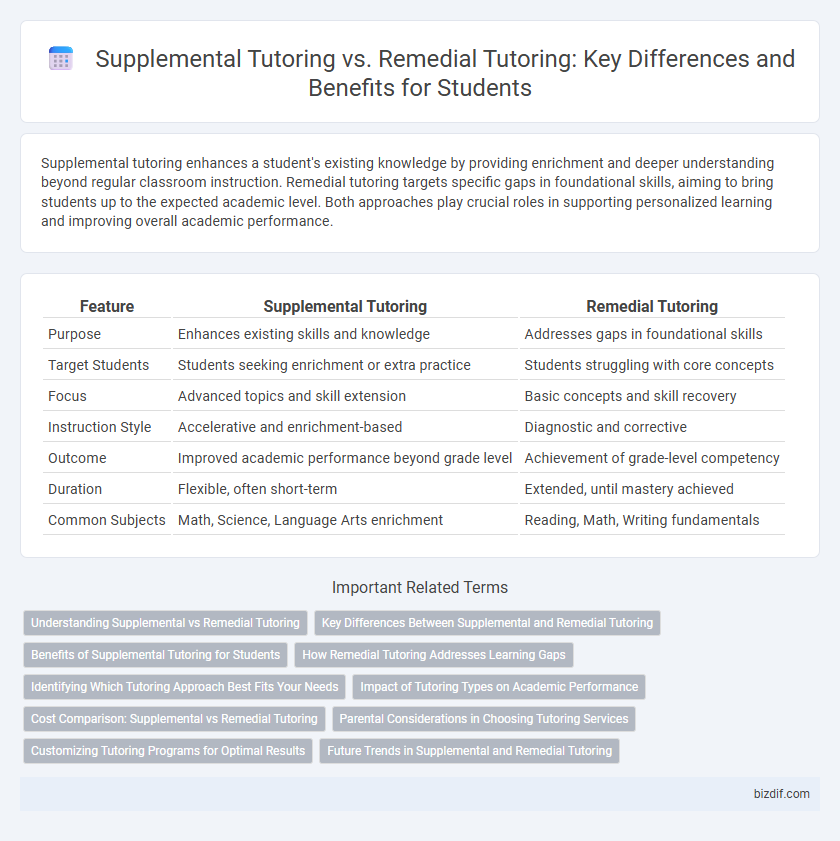Supplemental tutoring enhances a student's existing knowledge by providing enrichment and deeper understanding beyond regular classroom instruction. Remedial tutoring targets specific gaps in foundational skills, aiming to bring students up to the expected academic level. Both approaches play crucial roles in supporting personalized learning and improving overall academic performance.
Table of Comparison
| Feature | Supplemental Tutoring | Remedial Tutoring |
|---|---|---|
| Purpose | Enhances existing skills and knowledge | Addresses gaps in foundational skills |
| Target Students | Students seeking enrichment or extra practice | Students struggling with core concepts |
| Focus | Advanced topics and skill extension | Basic concepts and skill recovery |
| Instruction Style | Accelerative and enrichment-based | Diagnostic and corrective |
| Outcome | Improved academic performance beyond grade level | Achievement of grade-level competency |
| Duration | Flexible, often short-term | Extended, until mastery achieved |
| Common Subjects | Math, Science, Language Arts enrichment | Reading, Math, Writing fundamentals |
Understanding Supplemental vs Remedial Tutoring
Supplemental tutoring enhances a student's learning by providing additional practice and enrichment beyond the standard curriculum, targeting skill reinforcement and academic advancement. Remedial tutoring focuses on addressing specific learning deficits and gaps to bring students up to grade level proficiency, often concentrating on foundational skills like reading, math, or language arts. Understanding the distinction between supplemental and remedial tutoring helps educators tailor instruction to meet individual student needs, improving overall academic outcomes.
Key Differences Between Supplemental and Remedial Tutoring
Supplemental tutoring provides enrichment beyond standard classroom instruction, targeting students who seek to deepen understanding or accelerate learning in subjects such as math, science, or language arts. Remedial tutoring is designed specifically for students who struggle to meet grade-level expectations, focusing on foundational skills and knowledge gaps in reading, writing, or arithmetic. Key differences include the objective--enhancement versus remediation--and the student population served, with supplemental tutoring benefiting advanced learners and remedial tutoring supporting those needing academic recovery.
Benefits of Supplemental Tutoring for Students
Supplemental tutoring enhances students' understanding by reinforcing classroom learning, leading to improved academic performance and higher confidence levels. It addresses individual learning gaps while accelerating mastery of new concepts, promoting long-term educational success. This proactive approach supports personalized instruction, catering to diverse learning styles and fostering student engagement beyond standard curricula.
How Remedial Tutoring Addresses Learning Gaps
Remedial tutoring specifically targets learning gaps by providing personalized instruction that reinforces foundational skills students have missed or misunderstood. It uses diagnostic assessments to identify weaknesses and creates tailored lesson plans to build competence in core subjects. This focused approach helps students catch up to grade-level expectations, improving overall academic performance.
Identifying Which Tutoring Approach Best Fits Your Needs
Supplemental tutoring enhances a student's existing skills by providing enrichment beyond the standard curriculum, ideal for learners aiming to advance or deepen their understanding. Remedial tutoring targets specific gaps or weaknesses, focusing on foundational concepts to help students meet grade-level expectations. Assessing academic performance data and learning goals can clarify whether supplemental or remedial tutoring best aligns with individual needs for optimal educational outcomes.
Impact of Tutoring Types on Academic Performance
Supplemental tutoring enhances academic performance by reinforcing classroom learning and promoting mastery of new concepts, leading to improved grades and deeper understanding. Remedial tutoring targets specific gaps in foundational skills, helping students overcome weaknesses and achieve grade-level competency, which often results in significant gains in standardized test scores. Both tutoring types contribute to academic success but differ in focus: supplemental tutoring advances overall learning, while remedial tutoring addresses deficits to build essential skills.
Cost Comparison: Supplemental vs Remedial Tutoring
Supplemental tutoring typically costs less than remedial tutoring because it focuses on reinforcing existing knowledge rather than addressing significant learning gaps. Remedial tutoring often requires specialized instruction and more intensive sessions, increasing overall expenses. Parents and educators should weigh these cost differences when selecting the appropriate tutoring approach for student needs.
Parental Considerations in Choosing Tutoring Services
Parents choosing between supplemental and remedial tutoring often evaluate their child's specific academic needs and learning goals. Supplemental tutoring enhances understanding and enrichment beyond classroom instruction, while remedial tutoring targets skill gaps and foundational weaknesses. Budget constraints, tutor qualifications, and the child's motivation level are critical factors influencing parental decisions.
Customizing Tutoring Programs for Optimal Results
Supplemental tutoring enhances a student's existing knowledge by reinforcing concepts and providing enrichment beyond regular classroom instruction. Remedial tutoring targets specific learning gaps, focusing on foundational skills to bring students up to grade level proficiency. Customizing tutoring programs involves assessing individual needs, enabling tailored strategies that maximize engagement and accelerate academic progress.
Future Trends in Supplemental and Remedial Tutoring
Future trends in supplemental and remedial tutoring emphasize personalized learning through AI-driven platforms that adapt to individual student needs, enhancing engagement and effectiveness. Increased integration of data analytics enables real-time progress tracking and tailored interventions, optimizing learning outcomes in both supplemental and remedial contexts. Virtual and hybrid tutoring models are expanding accessibility, offering flexible schedules and diverse resources to support continuous academic improvement.
Supplemental Tutoring vs Remedial Tutoring Infographic

 bizdif.com
bizdif.com